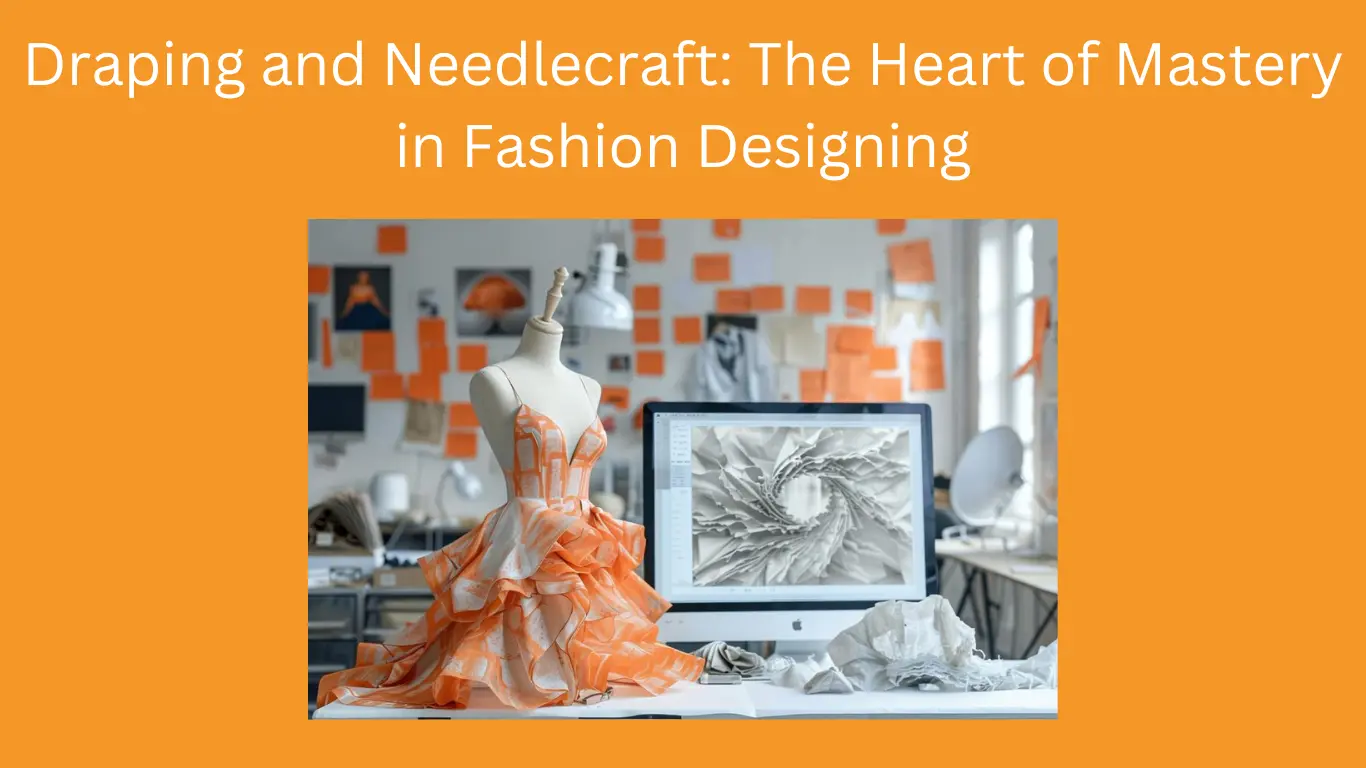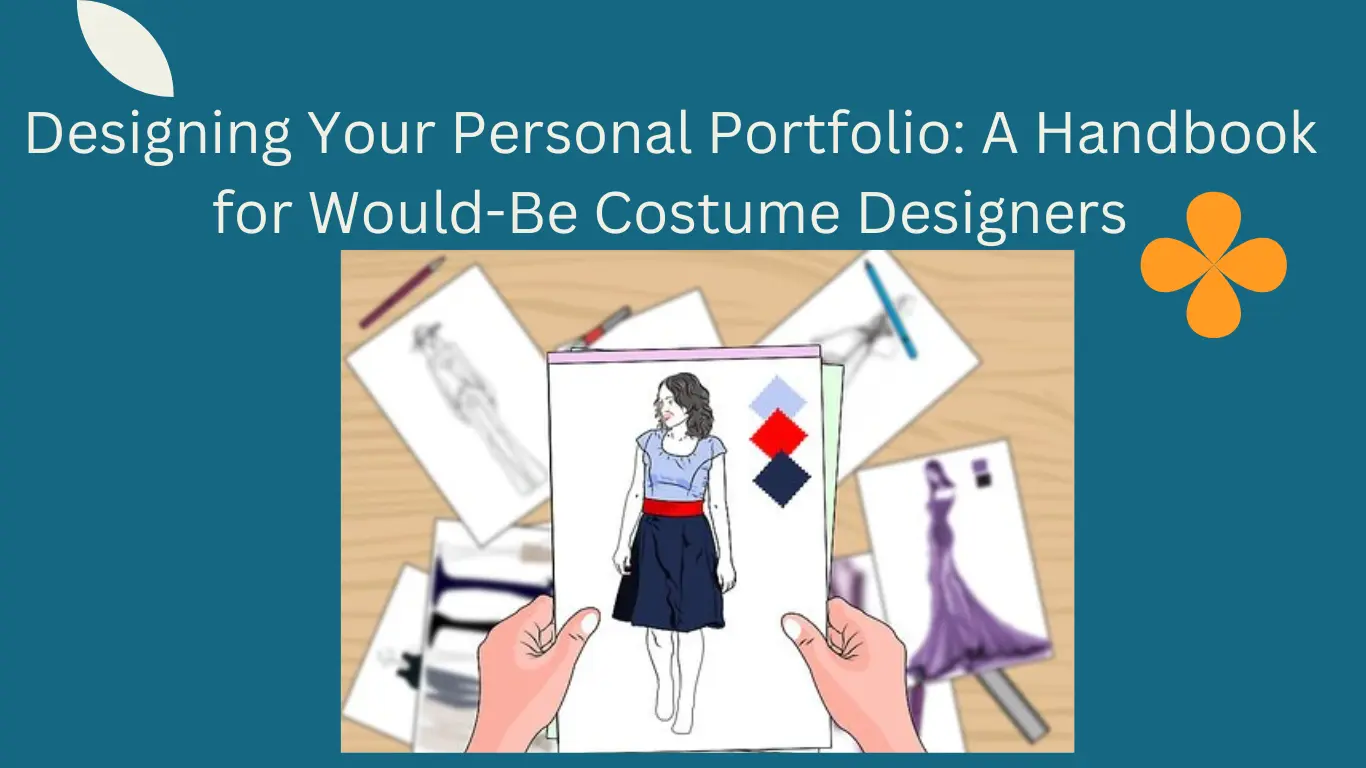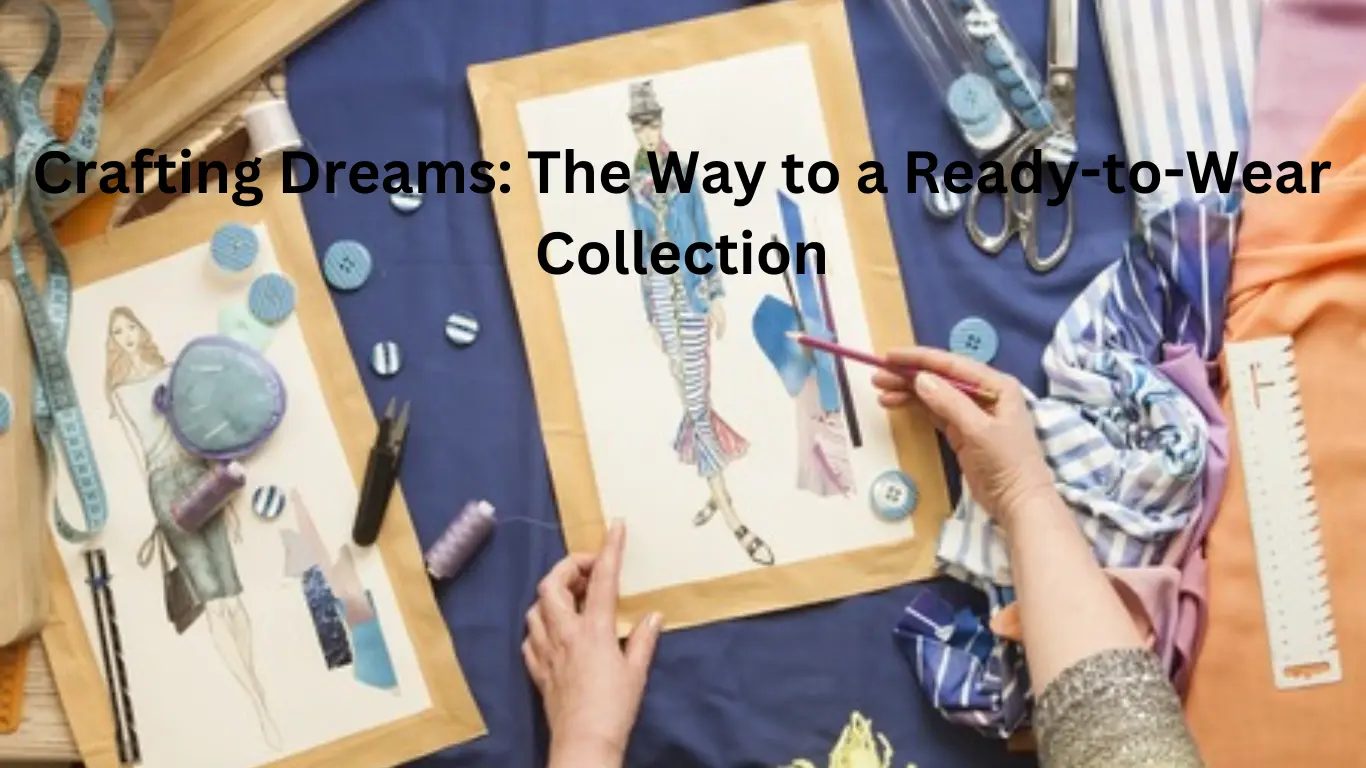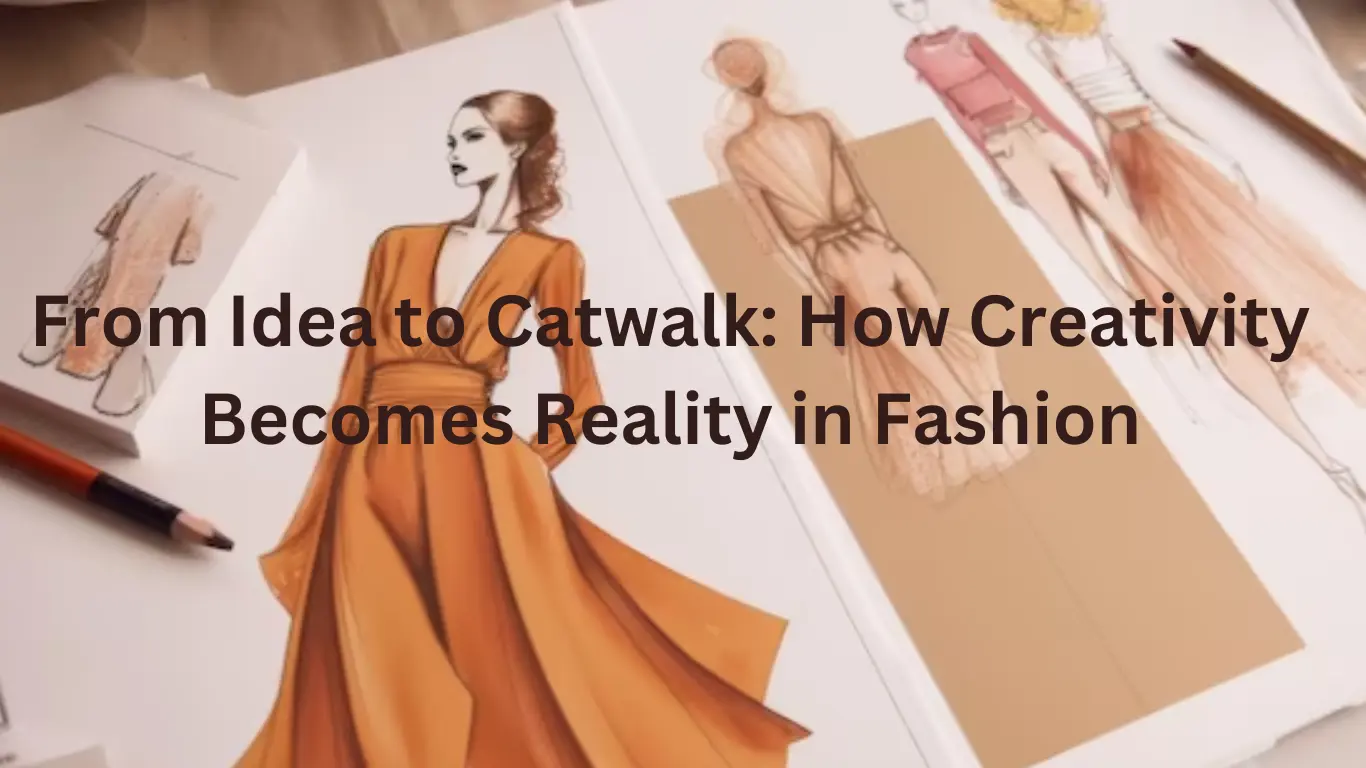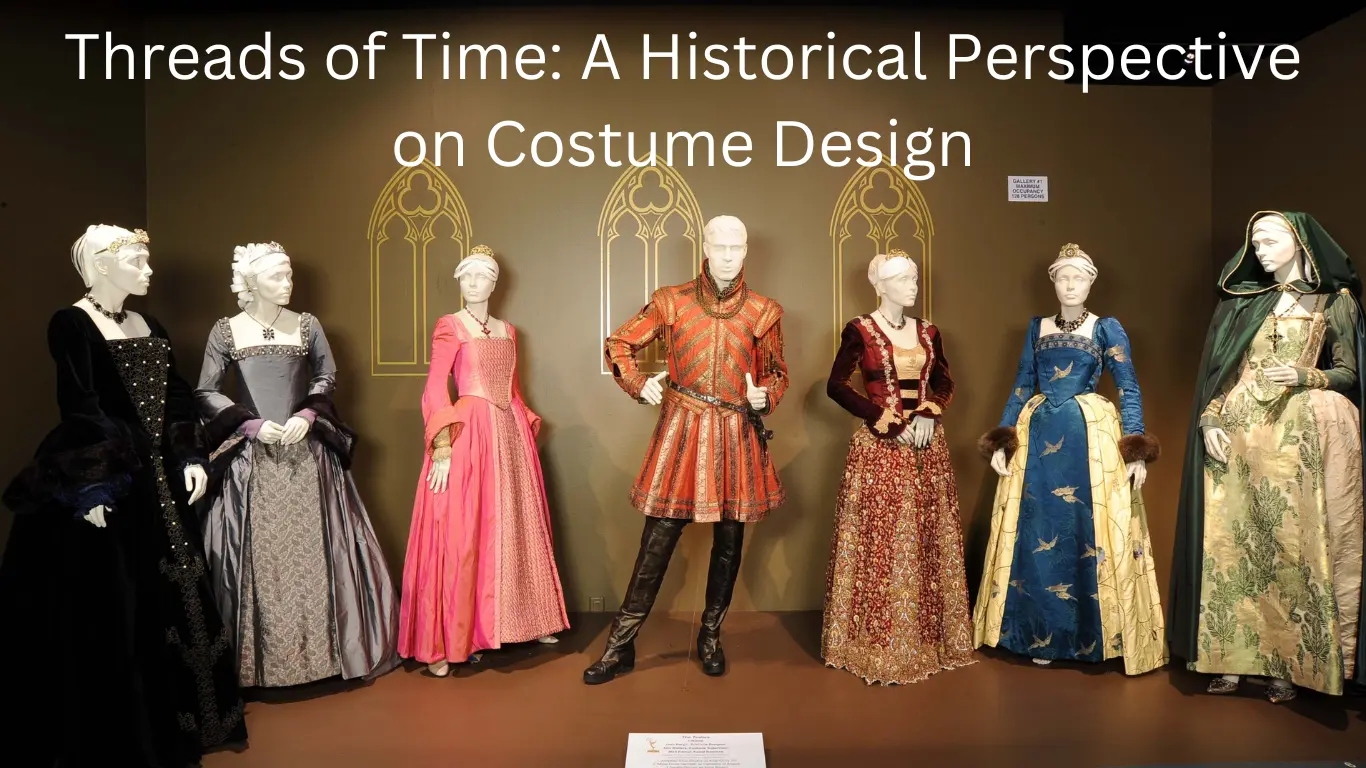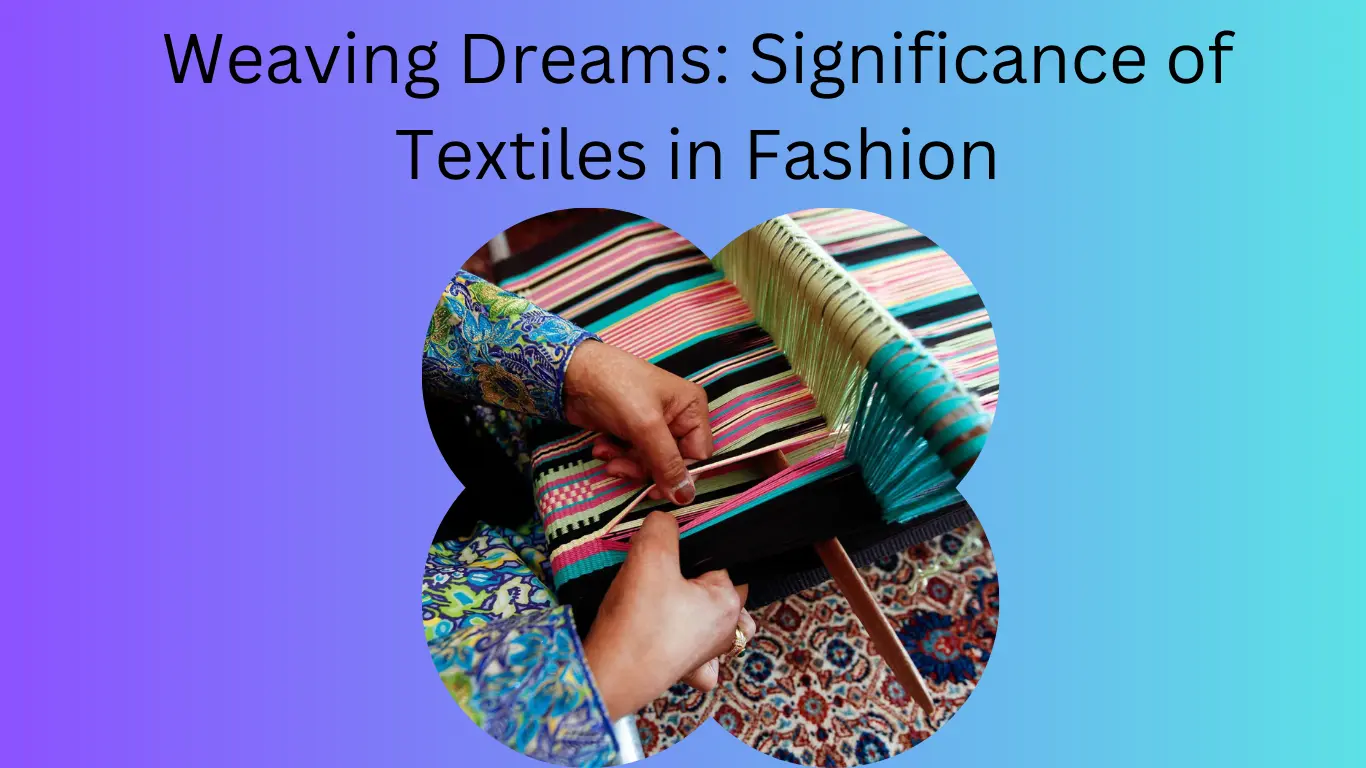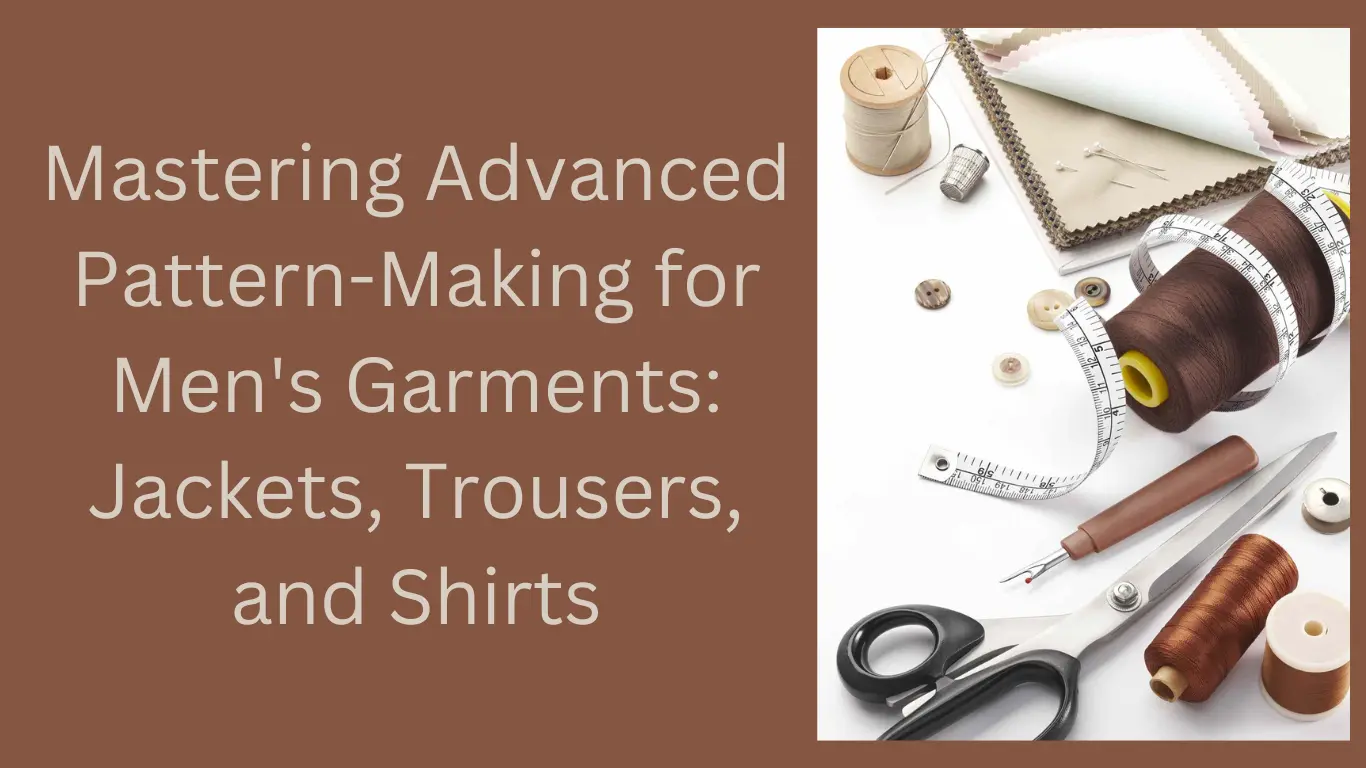Draping and Needlecraft: The Heart of Mastery in Fashion Designing Imagine walking into a bright studio, full of fabrics thrown about and literally alive with creativity and ambition. You grab some muslin and begin draping over a dress form, envisioning the elegant gown coming to life. Mastering draping and needlecraft is one of the crucial aspects for an aspiring costume designer or fashion student to develop his ideas into astonishing realities. The following content will explain the importance of these essential skills and provide tips for developing them so your designs always capture many hearts. Why is draping important for fashion design? It’s more than a technique; it is a vital element of the design process, allowing you to see and experiment with fabric in three-dimensional form. Unlike two-dimensional flat pattern-making, draping allows manipulation of fabric, with possible resultant forms and silhouettes that can be altered immediately. This allows hands-on creativity as you understand how your chosen fabrics will behave, and you make better-informed design choice. You can envision yourself standing in front of your dress form, with fabric flowing adroitly around it, tucking and pinning the material together into something which, in your mind’s eye, marks the final picture. Each fold and dart manages to tell a story of the design, resulting in the interplay between the texture of the fabric and the intended silhouette. As you master draping, you are able to design garments which look great on paper but look equally stunning when worn. This skill is particularly essential for costume designers since you can create pieces that can enhance character development and storytelling in film and theater. So, how do you master the art of draping? Begin with Basics: Here, again, do not confuse with novelty designs. The draping process really starts from some basic techniques. Although darts, pleats, and gathers are easy enough to draft up on a dress form, shaping the silhouette of these into the fabric on the mannequin requires practice. Set up your dummies in different manipulations with different fabrics as to see how those react to your handling. You may want to keep a journal of your experiments, listing what works and what doesn’t. Use the Proper Tools. Nothing less than the right tools can serve you well in a draping session. Develop some quality pins, fabric scissors, measuring tape and a dress form that fits you or for which you regularly make designs. You can even start out with inexpensive fabric such as muslin in order to practice without worrying about the cost of expensive materials. Learning from Others: Utilize the fashion styling courses in Chennai with trainees having experience, to allow experienced instructors to guide you through actual hands-on and feedback sessions. Working with fellow students may be helpful, as you’ll find others who are going through the same experience as you, whose techniques might inspire you in particular ways, and develop your style. Learning from others can even enhance your understanding of draping by observing their techniques and approaches. Why is needlecraft important to a fashion designer? Needlecraft entails the ability to sew, stitch, and finish sewing techniques. It is what actually brings your designs alive; with the ability to construct beautiful and robust well-finished garments from your idea. All this falls within needlecraft, whereby the idea in your head translates into real life as you stitch. All these have to be precise and creative at every stitch. Now, think about the satisfaction of draping your fabric into a finished garment. Every stitch is one step closer to that perfect fit and that style. With needlecraft, you can add further detail to your designs, incorporating decorative stitching or embroidery-making every piece uniquely yours. In costume design, little details may make all the difference in making a piece believable and appealing. What Tips Can Help You Be Good at Needlecraft? Practice, Practice, Practice: Similar to draping, more practice will make the needlework better. Try simple sewing projects to get you going. The more confident you get with the sewing machine and hand-stitching techniques, the more you will challenge yourself with complicated garments. Do not hesitate to refer to sewing books or online tutorials if you fail. Pay attention to details: detail makes all the difference in fashion; so take time to master things such as hemming, seaming and finishing edges. It will take you a little while to learn about different kinds of stitches, as it was surprisingly hard to get used to the final look and feeling of garments once you had introduced these stitches. For example, an apparently simple topstitch can dramatically change the design and provide an ending with polish. Fail-Wrangling: Mistakes are part of the learning process. Do not get discouraged; mistakes should actually be seen as a growing experience. Analyze them to determine what went wrong and how you can improve for the future. This mindset will enhance your skills and build your resilience as a designer. How do Draping and Needlecraft advance your career in fashion? Being able to drape and needlecraft is a good way to distinguish yourself as an aspiring costume designer or fashion student, especially in such a competitive business. They are not just technical skills but also empower you with creative talents, allowing you to create original product designs. Employers and clients appreciate designers capable of transforming ideas into the garment, which makes it a precious asset for you in the industry. Additionally, mastering draping and needlecraft can open up significant pathways in internship opportunities, collaborations, and freelance possibilities. As you continue building up your portfolio, their works in draping and sewing will reveal your quality and expertise, which are means of strengthening your professional status in the fashion world. Conclusion: Stitching Together Your Design Journey Draping and needlecraft skills are essentials that every new costume designer should take with them. They allow you to unlock your creativity, refine your craft, and produce great clothes that speak to your followers. Taking the time to perfect these arts will
Mastering Textile Care: Top Tips for Future Costume Designers
Mastering Textile Care: Top Tips for Future Costume Designers As a future costume designer, you know that fabrics will be the canvas of your creativity. Be it dressing a character for a blockbuster film or building a stunning outfit for the stage, your choices about textile care can make all the difference between the lasting message and presentation of your work. Welcome to your ultimate guide on textile care. In this guide, we first learn about different kinds of fabrics, the right techniques for stain removal, and some environmental-friendly practices that will keep your costumes looking fantastic. Understand Fabric Types: The Foundation of Textile Care First, you need to familiarize yourself with the different fabrics which you are to deal with in order to care for them properly. Silks and lovely luxurious fabrics all the way down to sturdier cottons, each with characteristics peculiar to it and a set of care needs. Imagine standing in a fabric store, surrounded by bright colors and rich textures. You reach out and touch a delicate silk shimmering in the light. Do you know how it must be cared for, however? Silk needs to be handled gently—usually hand-washed in cool water and a mild detergent. Cotton can take a little more abuse; it can often survive machine washing and even a tumbler. Knowing these differences will guide your choices in care practices. Once you are training on a course of costume design in Chennai, you are instructed about the properties of different textiles and how it affects the care regime. That is how you can assure a careful care lifecycle of your designs. What Are the Best Stain Removal Techniques? Working with textiles, especially in the high-energy settings of film and theater, will inevitably mean living with stains. So don’t despair! The right techniques can conquer even the most tenacious stains without harming your fabrics. Act fast. The faster you treat the stain, the easier it will be to remove. For protein-based stains like blood or sweat, cold water is your best friend. Run cold water over the item and gently use a mild soap or a stain remover on the affected area. For oil-based stains like make-up or grease, sprinkle some cornstarch on the stain to absorb the oil and then gently brush off the powder before washing. You’ll probably find yourself in a rush often as a costume designer; it can literally be a lifesaver to have on hand a stain removal kit. Pack essentials such as stain remover wipes, a small bottle of detergent, and a soft brush for gentle scrubbing. I vividly remember a frantic dress rehearsal at which a quick trick saved a beautiful costume just in time before the show! How might I work on gentle textile care in an environmentally friendly manner? With the rise of the fashion industry, there’s a parallel development in what should be done with the responsibilities of sustainable methods to be practiced. Being a future designer, you hold the power in the choice of selecting some eco-friendly alternatives in regard to the care of textiles. Start with the detergents you’re using. Most of the over-the-counter laundry products contain harmful chemicals that could impact the environment. Try biodegradable and eco-friendly detergents that are gentle on the fabrics and kind to the planet. In addition, whenever possible, do your washing in cold water. It protects the fibers while at the same time helps save energy, thus leaving you with a reduced overall footprint. Another sustainable practice is not over-washing. Many clothes do not necessarily need to be washed. Instead, you can air out costumes after wearing and spot clean as needed. Not only does this help extend the life of your clothing, but it also helps the fashion industry be more sustainable. What are some tips for proper storage of textiles? Once you have cared for your textiles, proper storage is key because how you store them will prevent wrinkles, fading, and pest-related damage. Breathable fabric garment bags work best for fabrics as fragile as silk or chiffon. Avoid plastic covers when the risk of moisture contact causes the growth of mold. Heavier fabrics like wool or denim fold very well, so fold them nicely and store them in a cool, dry space. You can also add cedar chips or put some lavender sachets inside to keep moths away. Plan storing by ensuring that your clothes are clean and wholly dry before placing them in storage. A little moisture is also enough to create mold and mildew. It’s the safe space for your fabrics until they’re put out to shine on stage or screen. Conclusion: Set Your Craft Apart with Excellence in Textile Care When becoming a costume designer, the knowledge of textile care is crucial to keep your creative vision intact. Care of the fabric type, removal of stain, and practices of environmental habit would ensure that your costume is kept in great condition over time. Care for your textiles is always going to be a key aspect in extending the length of wear, but it is also an indication of the care you put into your craft. Implement these practices, and your designs will thrive while knowing you are contributing to a more sustainable and fashionable future.
Mastering Apparel Quality Management: A Guide for Aspiring Costume Designers
Mastering Apparel Quality Management: A Guide for Aspiring Costume Designers In all the excitement about creativity — the textures, colors, and styles that bring characters to life — it’s easy to miss a very important factor in costume design: quality. Then comes apparel quality management! We will go over the fundamentals of inspection, testing, and quality in your designs here and lay a foundation for successful careers in fashion or film. Why Quality Management is Important in Costume Design Now imagine this: You have spent hours and hours tailoring a dazzling costume, and on the day of the show, it falls apart, bad stitching or mediocre materials having ruined the good work. A designer’s worst nightmare, I dare say! Quality management of an organization is not some background work; it rather forms an important part of the system, which would surely make sure that your designs stand firm to the harshest real-world realities. This, in turn, would affect the finish, fit, and overall presentation of your designs. It is completely pivotal in the fashion world, especially this mundane and competitive field. Quality management is the process of ensuring quality, each and every piece, through its systematic way of doing things by allowing each and every piece to meet the set standards before it reaches the final consumer – whether it’s the actor on a set or the audience in a theater. From the very first design sketches until the last fitting, the quality checks must always be observed to deliver the final output that goes exactly with what you want to produce as an artist and satisfies the consideration of film and television industries. What Are the Core Elements of Apparel Quality Management? In order to effectively and effectively manage apparel quality, you have to understand its core components. It can be broken down into three major ones: inspection, testing, and maintenance of standards. So, let’s discuss each of them in detail. Inspection is the checking of garments at different stages of production. This encompasses checking the quality of the cloth and how well and tightly the garments are stitched or constructed. It’s like giving your costume a comprehensive health check. I remember learning at the costuming course in Chennai that a sharp eye at the inspection phase can save a lot of headaches later on. If you notice that the fabric is fraying and the colors are inconsistent, for instance, you may treat this early; this will save you from costly mistakes later on. Testing takes quality assurance one step further. It is the process of checking how the materials and the finished garment would perform under various conditions. That would be testing whether the garment will last long, if colors would bleed, or how perfectly it drapes over an actor’s body. Think about it: You don’t want your costume to distort after a few scenes of intense movement. Rigorous testing ensures that your garment will withstand performance demands and not become a distraction. How Do You Ensure High Standards Through the Entire Design Process? It’s more of a journey to maintain high standards, and one does this by setting very clear and defined expectations and guidelines at the very beginning. As for leading, one could start with quality standards in the designs: what will you use, what kind of construction techniques will you apply? These should be according to the artistic vision as well as industry expectations. Among the most important tools that I learned about in the course is the quality checklist. Such a list maintains you on the right track through the entire design process to ensure everything turns out to your specifications. For instance, you would include criteria for the weight and count of fabrics used or a certain technique of stitching. Every time you end a garment, you go back to the checklist so nothing leaks out. Be willing to address issues with your team. If you are working with seamstresses, or sourcing fabrics, or any other partner, be sure to take your time explaining to them why quality matters. Then your team would share your vision and work even harder to deliver the best that could surface from the outcome. Possible Apparel Quality Management Problems The road to great clothes might be smooth, but there definitely are obstacles and challenges along the way. One of these more common barriers includes finding material that fits your quality standards while staying within budget. This would be quite daunting for an aspiring designer because you need to balance putting on good-quality fabrics that would stand out in your design while making sure the costs manage. Another dilemma is attaining an apt balance between artistic vision and practicality. Sometimes, a design so dramatic can compromise functionality and even comfort. The trick in overcoming these would be to make prototype pieces and hold fittings earlier into the design process. This allows you to catch problems before final production is done to ensure both quality and comfort. How Can Education Enhance My Understanding of Quality Management? Education is necessary to master apparel quality management. For example, a course in costume design, for example, in Chennai would probably give you some insight into industry standards and probably best practices on quality control. Working on practical projects and collaborations will help you have hands-on experience in quality management as well. Presently, seeking internships or an apprenticeship in costume design can provide insight into the processes involved with quality management. Working within the guidance of very experienced professionals will show you how you are going to apply quality assurance to real-world settings, further enriching your knowledge and skills. Conclusion: Quality Excellence is Yours for the Taking Mastering the basics of apparel quality management in the competitive world of costume design is to one’s advantage. And bring focus to inspection, testing, and the confluence of achieving your artistic vision to shine on stage or screen. Quality is an integral element of your story; claim it, and express your creativity in every piece
Designing Your Personal Portfolio: A Handbook for Would-Be Costume Designers
Designing Your Personal Portfolio: A Handbook for Would-Be Costume Designers The design portfolio is one of the most crucial things that any aspiring costume designer must set to work upon creating. It is your portfolio not only in terms of your skill but also a reflection of your personal style and all your creativity. Just imagine walking into a room full of industry professionals holding your portfolio in hand, feeling the rush and confidence. Your portfolio contains the magic key to unlock those doors to fashion and film. I am here to take you through this process of creating a highly effective collection about your target audience. What Makes a Portfolio Really Stand Out That special feeling when a design portfolio leaves you with an instant connection? Such is the magic of storytelling via visuals. A stunning portfolio is not merely telling the world about your work, but speaking about who you are as a designer. It’s all about taking all your experiences, inspirations, and skills together to build a comprehensive tale that draws and captivates your audience. First step: theme. Are you inspired by historical costumes, contemporary fashion, or perhaps the vibrant textiles of a different culture? Draw from this theme to help guide your portfolio. You might include sketches and swatches of fabrics, as well as photographs of completed pieces for a more dimensional view for your audience. For instance, if you have a specialty in period costumes, hang up not only the finished piece but also the research and inspirations that inform each piece. That will reflect not only your design process but also your attention to authenticity and detail-very valued in the costume design profession. What Can You Do To Show Off Your Distinctive Style? Being an aspiring costume designer, it is of utmost importance to reflect your unique style, which characterizes you differently from others. Consider what would define your aesthetic. Are you brighter in bold colors, intricate patterns, or minimalist design? Your portfolio must reflect such choices. You can separate sections in your portfolio by categorizing the work done into different themes or projects. You might have a theatrical costuming section, a film projects section, and possibly another for personal artistic explorations. Inside this you can add a little presentation explaining your approach, the concepts of the designs, and the philosophy of the work. This allows viewers furthering understanding behind design philosophy with care taken in each piece. Do you tell a story through what you do? Storytelling is at the heart of costume design. Every piece you create has a story, and your portfolio should tell that story. Consider what kind of characters and themes you want to be able to represent. Should you have done a film project, that adds some context surrounding the character and the story to the costumes. This is what adds depth to the designs and explains that you can indeed be a team player with directors and producers within the film and television industries. Show your design development from sketch to screen as costume in before-and-after photographs. That way, you’ll demonstrate not only technical skills but also your creative and thoughtful approach to design as a process. These are the stories hiring managers and industry leaders hear that speak to them, looking for designers to make meaningful contributions to their projects. How do you balance your portfolio to meet targeted markets? The key to creating your portfolio is to understand who your target market is: do you want to work in theater, film, or fashion? And in each industry, there are different expectations and aesthetics. Study the industry standards in each area and watch what award-winning designers put in their portfolios, then make yours accordingly. For example, if you aim at film, post pictures of high-definition pictures of your costume at work. But if this is the way to becoming a fashion designer, show off your creativity and flexibility in fabricating wearable art by posting photos of various styles, from avant-garde designs to commercial versions in trying to pinpoint the number of designs that you can produce and keep up with the trends of the market. Do You Use Your Academic Background? If you have done a course in fashion styling in Chennai, make sure to flaunt it in your portfolio. Since education is a powerful tool to authenticate your work, describe the projects done in your coursework and how these helped you hone your skills and finally chisel your designs. That will also put context into your design decisions by letting the audience understand the technical savvy and creativity you can bring to the table. Share stories of learning experiences: perhaps a difficult project forced you to think outside of the box or a collaboration that you learned about teamwork in costuming. Conclusion: Your Journey Starts Here As you start to create your design portfolio, always keep in mind that it reflects your individualistic artistic voice, so embrace your experiences and showcase your creativity and relation of your work with your target market. Remember, your portfolio is not just images; it is proof of your growth and passion for the craft itself. Sharing your personal narrative and thoughtfully presenting your designs will give you, besides a standout portfolio, a key to doors, to new and exciting opportunities in costume design. So, go ahead and start building that collection of dreams!
Crafting Dreams: The Way to a Ready-to-Wear Collection
Crafting Dreams: The Way to a Ready-to-Wear Collection Introduction: The Canvas of Fashion Welcome to the magical world of fashion design: the tale of every stitch and fabric fragment. Stand before a blank canvas with ideas floating around in your mind, taking all these fragments of thoughts and weaving them into a vision that only awaits itself to be lived. Designing a collection for ready-to-wear means a whole lot more than just making clothes. It is an expression of creativity, understanding the market, and mastering the technical aspects of design. This journey will inspire and equip an aspiring costume designer, a fashion design student, or a professional in the film and television industry with valuable insights into the process of bringing a collection to life. What comes first? How do you start thinking about your collection? This is at the start, a concept. Before you start playing with fabrics or sketching out your first design, you have to have a clue about the theme and storyline that your collection will tell. What mood do you want to evoke? What messages do you want your pieces to send? Inspiration Inspiration can be sparked anywhere—one may find it while taking a walk through nature, by a captivating book, or even a beautiful cityscape. Imagine walking the streets of Chennai-a vibrant tapestry of culture and heritage. As you take in your visual and emotional prompts, jot down notes, create mood boards, and collect any images that resonate to your theme. These will become the foundation for your collection-guiding fabric selection and design choices. Drawing Your Ideas Now that you have a good idea of your concept, it’s time to put your ideas onto paper. This is the stage at which you begin drawing out your ideas to see how all will come together. Remember to draw silhouettes, proportions, and details. At this point, also consider how each piece plays a part in your overall collection. Think about this for a moment: every drawing is a window to your creative mind. It’s an invitation to the viewer to imagine the textures, colors, and movement of the garments. As you draw, remember that it’s not perfectness that matters, but rather expression. Your drawings should be an extension of only you and all your style. Choosing the Right Fabrics: The Soul of Your Collection Now that you have your sketches in hand, it’s time to venture into the world of fabrics. The right fabric can make or break your designs-elevate their aesthetic and functionality. Imagine running your fingers over a luxurious silk, feeling the weight of a structured wool, or experiencing the flow of a lightweight chiffon. Each fabric tells its own story and can drastically change the feel of your collection. Understanding Fabric Properties The information and knowledge above of the characteristics of different types of fabrics should guide your selection of which fabrics to use based on your design concept and who your market is. For instance, if you target a young fashionable target market, light and airy fabrics are perfect for informal wear. Finding your fabrics Now’s the interesting part: sourcing! Visit the fabric markets, click through online suppliers, or head to textile fairs. Let your hair down and be immersed in this world of interesting colors and textures- don’t even think of not experimenting with that. Studying textile market explorations as part of a costume designer course in Chennai can inspire and set up some unique materials that can make your collection stand out. REMEMBER also that sourcing likewise involves supplier relationship building, which might find you good deals on materials so special that not many other designers have them. Pattern Development: From Sketch to Reality You now have selected your fabrics. It’s high time to breathe life into your sketches. This is pattern development where artistry meets technical capability. How to Create Patterns The patterns are the blueprints of your design. They will determine the construction of each garment and, therefore, its fit and functionality. So, a pattern starts out in flat sketches and measurements, where accuracy is paramount-because small mistakes can follow into fit problems later. In terms of practical instruction, you may want to add courses or workshops in pattern making. Most costume designer courses taught in Chennai are in the nature of practical courses and result in successful mastering of the skill. Prototyping: The Test Garment Now create your patterns and then sew a prototype. The test garment will allow you to check the fit, flow, and overall appearance in your designs. Be sure to note adjustments as you work. You can always ask peers or mentors for feedback; constructive criticism is an excellent catalyst for improvement. Prototyping, by the way, is where you polish your designs, usually before you’ll produce it in its final run; that’s how you should know that it will do what you intended it to do and look the way you want it to. Market Positioning: Knowing Your Customer As your collection begins to take shape, you would want to place in the market. Who are your clients? What is it about fashion that they like? This will let you promote your collection most appropriately. Identify Your Target Market Take time to research your audience. Are they trendsetters, the eco-conscious shopper, or the luxury buyer? Their preferences will influence not only your designs but also the marketing strategy. You might design garments that are particularly sustainable or target certain lifestyles or catch the latest fashion trend. Develop a Unique Selling Proposition Your USP will differ your collection from others in the market. It could be a style, commitment to sustainability, or something innovative through the use of materials. This will help in giving clear direction in designing. It will eventually be the guiding light in all of your marketing. Conclusion: Art of Fashion Design Designing a readymade collection is a journey full of creativity, technical skills, and strategic thinking. A journey from conceptualization to fabric and market positioning, as each of the
From Idea to Catwalk: How Creativity Becomes Reality in Fashion
From Idea to Catwalk: How Creativity Becomes Reality in Fashion Welcome to the exciting world of fashion and textiles! Have you ever wondered what takes place from the time that a creative thought was first conceived till it goes down the runway or to a store? For the budding costume designer or student in a course for fashion design, this process is crucial. A tour with me, the up-and-down steps that breathe life into creative visions and turn them into market-ready products. The Spark of Creativity: Where Ideas Begin Every great fashion piece has an initial spark of inspiration. These could be from anywhere, ranging from nature to art, historical events, or even a very vivid dream. Imagine walking through a busy marketplace or through a peaceful forest; each visual cue might galvanize a fresh design concept. So, as a costume designer, what’s locked in your personal experiences or cultural heritage that you can tap into to feed your creative thoughts?. Once an idea has been conceived, it becomes conceptualized. Drawing is essential at this point—the act of scribbling down your thoughts helps clarify and refine your idea. Think of the legendary designers like Coco Chanel whose ideas from simplistic drawing became the classics. The sketches will now be your language to visual communication with other collaborators in the industry. As you study in costume designer school in Chennai, you can hone your sketching skills as one of the methods for articulating your creative concepts. How do designers develop their collections? This is where the preliminary drawings come together-it’s the gathering stage-and you’re now picking a concept or storyline for your collection. Perhaps it’s based on a culture, time in history, or social cause. Think about the punk rock movement and what its ideology meant to fashion in the 1970s; it was not just what you wore but what attitude that spoke to. You can then envision the target group. Who is it you are designing for? Understanding their tastes and lifestyle as well as values informs your design sensibilities. When there is a general theme, thought is then formalized on paper utilizing mood boards in colors, fabrics, and inspirational imagery that capture the ethos of the collection. It becomes possible to align your vision with the production team so that everyone is on the same wavelength. What Role Do Materials and Fabrics Play? Materials and fabrics provide the back bones of any fashion item. Whether it’s a costume or an outfit, choice of textile makes or breaks the design. As you progress in your course in costume designing in Chennai, make sure to know various properties of fabrics – you have to learn to distinguish between weight, drape, texture, and so on. And this will take you miles if you make appropriate choices within your imagination. Well, let’s talk about creating a flowing gown for a historical drama. As the fabric flows, so should be mirrored in a character’s emotions and story arc. Whether it is expensive silk, low-maintenance cotton, or strong polyester, each fiber has its own story. Also, sustainability is one very important area the fashion industry is concerned with nowadays. As a new designer, think about building sustainable materials that mirror the thoughts of your earth-aware consumers. How Does One Translate Designs into Market-Ready Products? Once your designs are set in stone and you know what your material is going to be, it’s production time. This is when you build your prototypes, which are often referred to as “samples.” These samples will give you all the necessary information on how well they fit and how to construct the garment. You may even decide how the garment should be constructed at this point. That design may not be practical after all or is too uncomfortable to wear. Now, you’ll have to work with artists and production crews. The idea is conveyed that the final product would represent your initial idea. This can be somewhat like a nice dance in which every step puts you closer to the catwalk. It also includes the knowledge of cost management-being innovative and commercially viable turns out to be the gold dust of the day in the marketplace. What Happens After Production? If a dress is made, then marketing and distributing it comes next. These processes can take the form of a fashion show, social media, and even advertisements. Just imagine a fashion show; your models walking along the runway to display your garments to potential buyers and influencers. It is more than the garments; it will be preached to your audience. Having an online presence today is absolutely a must. The tools offered through social media can make your brand reach out to more people so you can communicate directly with the consumer. This interaction can be invaluable in gaining what a customer likes and dislikes, helping shape future designs. As you step into the fashion industry, don’t forget to incorporate these marketing strategies to become successful. Conclusion: Your Journey in Fashion Awaits This is the adventure from creative idea through to market-ready product, characterized by creativity, collaboration, and strategic planning. Embracing every step of this process as an aspiring costume designer or fashion student will equip you with the skills you need to succeed in the fashion world. Remember, every stitch and seam is a step toward making your mark in this vibrant industry.
Threads of Time: A Historical Perspective on Costume Design
Threads of Time: A Historical Perspective on Costume Design Costume design is not just made of fabric and thread, but storytelling, culture, and history. Imagine taking a stroll through the market of old Rome or standing in the spotlight on stage of a grand theater where each garment tells a story. But, of course, for the budding costume designer and fashion students, especially who are undergoing a costume designer course in Chennai, will find much importance in knowing the historical roots of costume design and thereby enhance this craft further by being inspired to go on their creative journey. What is Costume Design and Why is it Significant? Essentially, costume design is greater than mere clothing. It is that blend of creativity, culture, and history molded from the social value system and human experiences. The elaborate regalia at the French court to the minimalist effects of modern cinema represent costume visual narratives that bring life to characters and submerged their audiences into their worlds. From the film and theater stages, costs in costume design extend into cultural celebration and daily life arenas. Traditional garments carry stories; often they bring heritage and identity with the person. Reflecting on your designs while studying costume designer courses at Chennai, do you think costumes have made great strides forward through the years? Technology, political elements, and social factors seem to have deeply influenced the costume designs, do not you think?. How did costume design change with time? Designing costumes dates back in the earliest of civilizations, where clothes were defining the class, occupation, or any other background of people. Nobility for instance dressed themselves up in a linen tunic decorated with gold and other precious stones. The common people wore simpler, practical clothes. Costume design itself evolved with the societies; the beginning of the Renaissance marked a change, and improvements in fabric manufacturing and dyeing allowed for more colorful, richer costumes. The lavish and intricate textures of the time said much about newly arisen prosperity but also about a newly revived arts and culture. Analyze how these changes shaped character developments and audiences’ perception as you flip through your costume history and set the stage for modern design practices. Costume design is certainly above the boundaries of pure vision; it reflects cultural values and social narratives. Every age has a trend that represents the ideals, struggles, and aspirations that produce a lifestyle for its people. For example, the flapper dresses of the 1920s represent the liberation and freedom of women from general roles, while the exaggerated silhouettes of the 1950s are celebrated as feminine and full of life within home. While studying about the effects of culture on costume designing during your course in Chennai, you will learn how modern-day designers seek inspiration from historical motifs. This dance of past and present enhances the storyline of modern costume design, and hence, it becomes imperative to comprehend the cultural value behind all your designs. Is Costume Design an Art Form? Costume design is an art. It is similar to painting or sculpture, because it requires an understanding of the total impact of color, texture, and composition. Costume designers are artists who, like others, communicate through their medium-garment-conveying emotions and taking storytelling to a higher level. Think about those iconic film costumes-the little black dress worn by Audrey Hepburn in “Breakfast at Tiffany’s” or the rich colors of the Wicked Witch in “The Wizard of Oz.” Each costume has been painstakingly designed to enhance the film character’s personality and story, effectively turning it into a significant element of the visual language. As you engage with artistic principles in your studies, consider how these elements will elevate your designs and leave an impression long after it’s viewed. What Can We Learn from the Past to Inform Our Future? As you embark on your career in costume design, remember that history is a treasure trove of inspiration. Coming to understand how costume design evolves before our very eyes gives you cause and effect by seeing the patterns and motifs that resonate through time. It empowers you to create works that speak to contemporary audiences while honoring their historical roots. Reflect on how your experiences and cultural background can inform your designs. What stories do you want to tell? How will you combine the influences of history into modern aesthetic so that something new is really achieved? Answering those questions will guide your process of creativity in developing your identity as a costume designer. Conclusion: Wearing the Threads of History into Your Designs In conclusion, costume design is a world rich in history and cultural significance. As you delve into this world, let the stories of the past inform your work, blending tradition with innovation to create costumes that captivate and inspire. Your journey through a course in Chennai is just the starting point-accept the legacy of costume design and see how it shapes your voice creatively.
Navigating the New Waves: The Changing Landscape of the Apparel Reta
Navigating the New Waves: The Changing Landscape of the Apparel Retail Industry Introduction: A New Chapter in Fashion Retail Imagine you walk into a world in which fashion is no longer about clothes but an experience-that changes with the needs and wants of consumers. This industry has essentially been impacted by change as brands have also tried to reshape their relationship with the customer through various retail channels. For you as aspiring costume designers and fashion design students, there is a crucial need to understand this landscape and how it can relate to your own future success in this ever-changing world of fashion. Let’s take a journey into this dynamic and exciting industry to understand the opportunities that these shifts can open for innovative designers like you. What Are the Key Retail Channels Shaping the Apparel Industry? Today, fashion no longer sells only in traditional storefronts. E-commerce, social media platforms, and innovative retail methods have made possible a plethora of channels- each with unique advantages. The E-Commerce Empowerment Imagine a busy online marketplace where consumers can simply browse through infinite options, compare styles from their homes, and buy as they please. That is exactly what e-commerce has done to revolutionize the process of apparel shopping from their homes. Consumers are now at liberty to tap into established brands, as well as newer designers, all within just a few clicks. As a fashion design student you would grasp that e-commerce is way more than just a sale; it is about experience. Brands should focus on an easy and non-cluttered website, enthralling visuals and an un-hassled check out so consumers are attracted to that as well. If you can understand e-commerce well, then you will get a better insight into it and place your designs across a more extensive audience. The Resurgence of Brick-and-Mortar Stores While e-commerce is booming, brick and mortar is certainly by no means dead. It is encouraging to note that consumers still have high appreciation for the feel of shopping in a physical environment. Imagine walking into a very tastefully curated boutique where one can touch the fabric, try on pieces, and get styling from informed salespeople. Today, retailers are responding to this demand for offline shopping by turning stores into immersive experiences. Be it private events or individualized fittings, brands are using customer experiences to drive foot traffic into their locations. As an emerging costume designer, this tells you that your designs must be transferrable online and offline and therefore must evoke the same brand expression through all channels . How Social Media Is Revolutionizing the Retail Industry The digital era has undoubtedly made social media a powerful tool of expression for fashion brands. Brands such as Instagram, TikTok, and Pinterest, among many others, offer the designer an invaluable platform to express their work and connect with the potential customer before building a community around the brand. Influencer Marketing: The New Avenue for Exposure Imagine scrolling through your feed and seeing that a famous influencer has posted a picture of herself wearing an amazing dress you designed. This is the marketer’s dream of marketing through influencers in the clothing industry Brands generally collaborate with influencers to reach eyeballs from the target group, using their already-existent followers to generate hype around new collection launches. For you, as a future designer, the potential of social media can catapult your career forward. You engage your audience, show them the process, collaborate with influencers, and build your brand to attract followers, including fashion enthusiasts as well as industry professionals. User-Generated Content: Authentic Engagement The trends the fashion retail space is embracing include user-generated content. When customers are taking pictures of themselves in your design and posting those on social media, a sense of community and authenticity is felt. That is an organic type of promotion that builds trust and ensures that others will be inspired to delve into your collection. As you build your portfolio, consider how you can encourage your customers to tell their stories of using your work. Asking them to tag you or to use a specific set of hashtags could create a highly active online presence for your work, further extending your reach. What Trends Are Shaping the Future of Apparel Retail? Apparel retail is in constant motion: consumer tastes shift, technology advances, and social dynamics change. Sustainability: A Unresolved Necessity Sustainability has been the increasing concern of the consumer in recent times. Most customers are interested in finding brands that grow through ethical practices, maintain an eco-friendly status, and produce products made from environment-friendly materials. Imagine a perfect future where each piece you design from sustainable fabrics and produces with clarity. This shift will give you one singular opportunity as a costume designer. If you have sustainable practices in your work, then rising numbers of environment-sensitive consumers will be attracted towards your work. During your Fashion designing course in Chennai, learning about various production techniques as well as sustainable materials would place you ahead of others in terms of creating designs which will be communicative in the context of an impact on the environment to a modern consumer. Technology Incorporation: Improvement of the shopping experience A change occurred in the relationship of brands and consumers where the incorporation of technology into retail is now the case. The apparel industry will be moving towards a new level as AR, VR, and AI are already penetrating the various sectors of clothing, providing unique shopping experiences for the customers. A virtual fitting room where your designs are seen on the customers without having them try them out. This is not only convenient but also decreases the chances of returns, so it can thus turn out to be a win for both the consumers and designers. Conclusion: Acceptance of Change in Apparel Retail The apparel retailing industry is great in transformation with e-commerce and the return of physical stores and social media. As both of you are costume designers-to-be and current students of fashion, it is necessary to keep
Weaving Dreams: Significance of Textiles in Fashion
Weaving Dreams: Significance of Textiles in Fashion What comes to mind when people think of fashion? Maybe it’s a bright run-way event or the perfect drape of haute couture. What, however, many consider unsung heroes are the excellent features of any appealing piece: textiles. At the bottom line, understanding textiles is the bottom line for anyone that wants to be a costume designer or work in the fashion industry at large, particularly when you are looking at taking up a course in being a costume designer in Chennai. Let us now delve into the world of textiles and see why they are so crucially integral to the fabric of fashion. What Are the Basic Properties of Textiles? Reflect on your feeling of wrapping yourself with that wool blanket on a cold evening. The feeling of being soft and warm is due to its properties. There are various kinds of textiles and characters that make them suitable for certain applications in fashion. Basic properties of textiles include but are not limited to, fiber content, texture, weight, and durability. For instance, natural fibers like cotton, wool ensure breathability and thus become best suited for daily wear. Synthetic fibers like polyester, nylon provide additional strength and are used in performance apparel. Knowing these makes sure you don the right textile for each design and therefore they look great and also feel great. Continuing as a costume designer in Chennai, you would keep on learning just how these properties affect the behavior of that garment. Imagine creating a costume for an opera performance: there must be resistance to movement and wear yet still look fabulous in the glare of bright stage lights. It is at this juncture of textile properties interacting with design potential that costume design comes alive. How Do Performance Properties Influence Fashion Decisions Now, think back to the last time you wore something that made you feel superhuman- probably a sharp suit for an interview or a flowing dress for a special occasion. The performance of textiles really plays a huge role in this kind of perception. Performance characteristics are basically how a fabric acts under particular circumstances. For instance, moisture-wicking fabrics are a requirement for athletic wear, since one would be doing water-intensive activities and therefore should not feel wet during such activities. Similarly, stretch fabrics are a must for free movement and thus for dance costumes. With all these in mind, you can choose textiles that do not only enhance the beauty of your designs but also contribute to functionality. As a future costume designer, consider how a textile may be used dramatically to change the body of a character. Heavy brocade speaks for royalty, but fragile chiffon speaks for vulnerability. Every selection that you could make will define the story that your costume says to the audience through a connection that goes deeper. What are the major steps in the manufacturing process of textiles? An appreciation of just how important the textile industry is to production will cause this rather complex production process involving textiles to be unpacked. How does that raw fiber become that exquisite drapery on the runway? Textile manufacturing procedure normally involves several steps; these typically include spinning, weaving or knitting, dyeing, and finishing. The first steps are spinning the fibers into yarn which is then woven or knitted into fabric. This stage has to do with creativity because there are several patterns and textures that can be produced. The finishing processes and dyeing are where the fabric comes alive. Colour is added, and treatments given for properties to be water resistant or fire retardant. During this course in costume designer training in Chennai, you will learn about these processes-how they change not just appearance but the sustainability impact of the fabric. In today’s fashion landscape, it is of utmost importance for a clothing designer to consider not just the aesthetic appeal of clothes but also their eco-friendly aspects as consumers are slowly starting to realize their impact on the environment. Textiles: Not only a material, but inspiration too How Can Textiles Inspire Your Design Process? Textiles can’t just be about a matter of practicalities; they’re forms of inspiration. Think back to when you used to walk through a fabric store and had an uptick in your creativity rubbing against all the different textures and colors? Each piece of fabric tells a story or can wait for you to give them life through your designs. As you start developing your skills, let yourself be inspired by the thousands of textiles you’re about to come face to face with. Just imagine how shimmering satin might transform a gown from earthy thread into ethereal and heavenly attire or how rugged denim will add an easy, casual feel. You’ll continue discovering all their different personalities and how they might influence your designs through more varied fabrics. Additionally, the world of textiles is always developing; new materials and technologies are coming up every single day. This would not only add beauty to your designs but also keep you ahead of the game in this competitive world. Conclusion: Why Textiles Matter More Than You Think Therefore, being an upcoming costume designer or someone working in the fashion business, it is very important that you embrace the importance of textiles for your own success. The understanding of their properties and performance characteristics form a base to produce something important; therefore, mastering the production of textiles is the root through which your creativity will grow. The next time you see a gorgeous outfit, pause for a moment to think about the textile behind it. It’s not just fabric; it’s the literal thread that weaves into the narrative that makes fashion.
Mastering Advanced Pattern-Making for Men’s Garments: Jackets, Trousers, and Shirts
Mastering Advanced Pattern-Making for Men’s Garments: Jackets, Trousers, and Shirts Learning advanced pattern-making techniques is crucial if you want to succeed in the fashion industry, particularly in the men’s wear sector. More than simply imagination is needed when designing high-quality coats, pants, and shirts; accuracy, technical know-how, and a thorough understanding of garment structure are all necessary. Whether you’re a student studying fashion design course in Chennai or an aspiring costume designer, mastering these strategies can help you stand out in the field. Let’s examine in more detail the sophisticated pattern-making methods that can turn your ideas from abstract thoughts into flawlessly fitted clothing. What Makes a Perfect Jacket? Crafting the Ideal Pattern Knowing both classic and modern patterns is essential to making the ideal jacket. In addition to defining the silhouette, a well-designed jacket pattern guarantees the finished item’s comfort and style. Gaining proficiency in advanced pattern-making for jackets entails learning how to draft the shoulder slope, chest breadth, and armhole construction. To begin, make a simple block that will act as your base. Next, modify it to fit the particular style of jacket—a dressy trench coat, a casual bomber, or a fitted blazer, for example. It’s important to pay close attention to the details: the sleeve should fit comfortably around the armhole, the lapels should roll appropriately, and the shoulder seam should line up exactly. Every one of these components is essential to the jacket’s overall fit and style. Anecdote: I recall my first jacket design, which I created for a customer who desired a fusion of modern and classic styles. Finding a balance between the customized fit and modern features like a narrow profile and minimalistic design proved to be difficult. But I was able to make a jacket that was both fashionable and practical by meticulously modifying the pattern and holding multiple fits, which is evidence of how important accuracy is when creating patterns. How Do You Achieve the Perfect Fit for Trousers? To get the ideal fit in pants, one must have a thorough understanding of pattern-making and garment manufacturing. Precise measurements and modifications are crucial. Start with a basic block of trousers and adjust it to fit several styles, such as high-waisted, relaxed, or slim-fitting pants. Pay attention to factors such as the leg breadth, the seat area, and the rise (the distance from the waistband to the crotch). When necessary, add pleats or darts to improve fit and comfort. To get a unified look, keep in mind that the pants should go well with the jacket and top. For a clean finish, methods like balancing the waistline and aligning the side seams correctly are essential. Personal Insight: I once worked on a project where the client needed trousers that could transition seamlessly from day to night. By experimenting with different fabric weights and adding a discreet stretch, I was able to create trousers that were both stylish and versatile, highlighting how intricate pattern adjustments can impact the garment’s functionality and style. What Techniques Ensure a Well-Fitted Shirt? A well-fitting shirt is a staple of any wardrobe, and creating effective patterns for them requires knowing things like body fit, sleeve lengths, and collar styles. Drafting patterns for various collar designs (such as spread, button-down), sleeve variants (such as set-in, raglan), and modifying the body fit for various silhouettes are examples of advanced shirt pattern-making processes. Start by taking accurate measurements and using these to draft a basic shirt block. From there, make adjustments based on the desired style—whether it’s a fitted dress shirt or a relaxed casual shirt. Pay special attention to the collar stand and band, as these elements significantly affect the shirt’s overall look and comfort. Design Tip: For a custom project I worked on, the client requested a shirt with an unusual collar design. By carefully drafting and testing the collar pattern, I was able to achieve a unique look that still maintained functionality and comfort. This experience underscored the importance of flexibility and creativity in pattern-making. How Does Advanced Pattern-Making Influence Garment Construction? Cutting-edge pattern-making techniques have a big impact on how clothes are made. Precise designs result in better-fitting and superior final goods. For coats, pants, and shirts, exact pattern modifications guarantee that all the components—seams, linings, and everything—align precisely. Accuracy and efficiency can be increased by employing methods like making muslins, or sample clothes, for fittings and by utilizing contemporary equipment like CAD software. Designers can produce clothing that satisfies the greatest standards of craftsmanship, expedite the building process, and minimize errors by implementing these cutting-edge techniques. Sector Perspective: I’ve seen firsthand how digital tools for creating patterns can completely transform the design process. These tools allow for rapid adjustments and provide a clear visual representation of how patterns will translate into finished garments, making it easier to perfect every detail.

